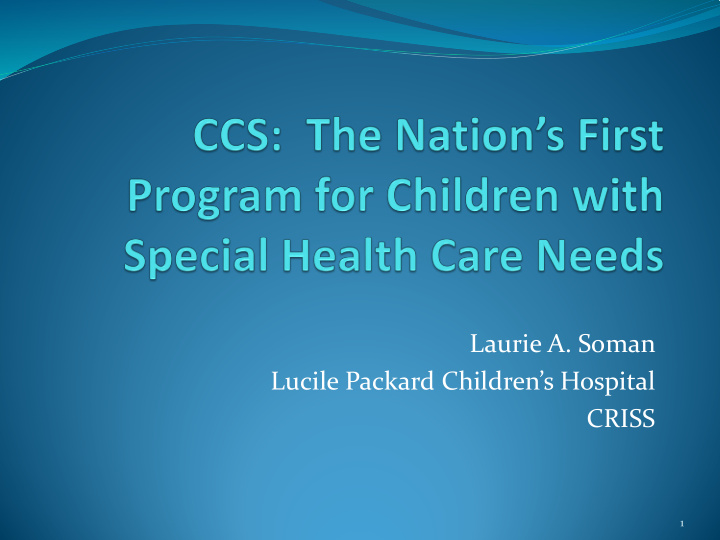



Laurie A. Soman Lucile Packard Children’s Hospital CRISS 1
Birth of CCS Program CCS Program Established in 1927 for “Orthopedically Handicapping Conditions” “CCS” Originally “Crippled Children’s Services” Response to Polio Epidemic of 1900-1960 Designed to Protect Middle Class Families from Financial Catastrophe from Medical Costs Federal Social Security Act Title V Established in 1935 Program Name Changed to “California Children’s Services” in 1982 Until 1982 CCS Income Ceiling Was $100,000/year 2
What Is CCS? Addresses Acute or Chronic Medical Conditions, e.g. Cancer Infectious Diseases Congenital Heart Disease Cerebral Palsy Hemophilia Spina Bifida Sickle Cell Disease Cystic Fibrosis Conditions Added Over Years Since 1927, Often by Legislation or Regulation Does Not Cover Typical Primary Care Does Not Cover Developmental Delay/Disability Will Cover Mental Health Services as They Relate to Eligible Medical Condition 3
What Is CCS? CCS Provides Children and Families with: Diagnostic and Treatment Services for Eligible Conditions Medical Case Management Physical and Occupational Therapy Two Wings of Program Treatment Program: Diagnostic and Treatment Services for Medically Eligible Condition Medical Therapy Program: Physical and Occupational Therapy for Eligible Conditions, including at School Sites 4
Why CCS Case Management? Assures that CCS Children and Families Get “Right Care at the Right Place at the Right Time” Built on Statewide Network of Approved Pediatric Providers, Hospitals, and Special Care Centers Authorizes and Pays for Health Care for Treatment of Medically Eligible Condition or Complications of Condition Tailors Authorizations to Specific Needs of Child and Family Coordinates with Special Education, Regional Centers, Medi-Cal Managed Care Plans, and Others 5
Who Are CCS Children? Program Caseload ~175,000 Children/Youth Aged 0-21 Income/Insurance Status ~90%: Medi-Cal (including former Healthy Families-eligible children) ~10% No insurance or underinsured 6
Who Are CCS Children? Top 5 Medical Conditions (2010*): Congenital Heart Disease (16,750 cases) Hearing Loss (14,093) Cerebral Palsy (13,772) Diabetes (6,700) Malignancy (6,165) Top conditions = 1/3 of total caseload for 2010 Age Spread (2010*) Largest Single Age Group 0-1 Year Olds After 3 Years of Age, Numbers Fairly Stable Across Ages * Data from presentation by Dr. Marian Dalsey, Children’s Medical Services, 2/9/10 7
Percentage of CCS Medi-Cal Expenditures by Medical Condition Total Expenditures $1.69 Billion -- FY 2008-09 Prematurity 26% Other Conditions 52% Cardiac 7% Malignancies 6% Coagulation Infectious Disorders Diseases 5% 4% * Data from presentation by Dr. Marian Dalsey, Children’s Medical Services, 2/9/10 8
Who Are CCS Children? Program Costs: $1.8 Billion/Year (2010*) Some children very expensive: 10% of CCS enrollees = 72% of CCS patient care expenditures ^ Most children are not: 50% of CCS enrollees= 2% of CCS patient care expenditures ^ Overlap with Other Systems (e.g. Mental Health, Regional Center, Special Education, Foster Care) We know many CCS children are served by other systems, but numbers are hard to find * Data from presentation by Dr. Marian Dalsey, Children’s Medical Services, 2/9/10 ^ Data from Center for Policy, Outcomes and Prevention, Stanford, 11/13 9
CCS Sets State Pediatric Standards CCS Standards Drive California’s Statewide Pediatric System of Care State CCS Develops State Standards for Pediatric Providers, Hospitals, and Special Care Centers Panels Individual Providers Approves Special Care Centers Approves NICUs, PICUs, and Hospitals Quality Data Collected on NICUs Quality Data Now Being Collected on PICUs 10
Why Are Statewide Pediatric Standards Important? Children with serious and/or rare medical conditions have better outcomes when treated by providers and hospitals with pediatric expertise. High volume of cases treated leads to better outcomes. Only specialized pediatric centers see the number of many children’s conditions needed to reach volume thresholds for quality. Children are not short adults; they and their families need access to physically, developmentally, and socially appropriate services and facilities. State CCS standards help to enforce and maintain the statewide system of care that ensures access to pediatric expertise, quality outcomes, and child- and family-centered care. 11
CCS and Medi-Cal Managed Care State Medi-Cal Managed Care Roll-Out Began 1994 CCS Carved Out from Medi-Cal Managed Care via Specific Legislation: SB 1371 (Bergeson), 1994 CCS Carve-in Counties Permitted under SB 1371 or added shortly after Marin, Napa, San Mateo, Santa Barbara, Solano, and Yolo CCS Carve-out Counties Rest of State Has CCS Carve-Out from Managed Care Includes Counties New to Medi-Cal Managed Care Current CCS Carve-Out Ends December 31, 2015 More to come……… 12
In 1952 the Social Security Administrator for the United States wrote (with 1952 terminology): “One of the best tests of a civilization is its concern for its handicapped members, and particularly for its handicapped children.” This is still true. 13
For More Information CCS Program, Department of Health Care Services: http://www.dhcs.ca.gov/services/ccs/Pages/default.aspx Center for Policy, Outcomes and Prevention at Stanford: http://pediatrics.stanford.edu/cpop/ Lucile Packard Foundation for Children’s Health Program for Children with Special Health Care Needs: http://lpfch-cshcn.org/advocacy/ 14
Recommend
More recommend